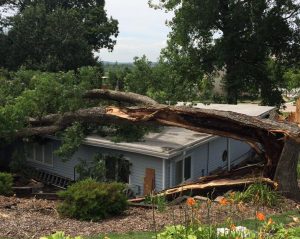Blog, Emergency Tree Care, Plant Health Care
Tree Risk Assessments Help Minimize Storm Damage Potential
 Unless you haven’t left your home for the past month, this announcement will come as no surprise: Spring / summer storms have arrived.
Unless you haven’t left your home for the past month, this announcement will come as no surprise: Spring / summer storms have arrived.
With much of the St. Louis area still recovering from the recent flooding that left many riverfront communities under water, it is past time to begin considering how to safeguard your family and your property from potential storm damage.
While you cannot completely protect yourself from extreme weather conditions like tornados and floods, you can take steps to mitigate the inherent damage potential of spring and summer storms. This is particularly true when it comes to the trees on your property, which can cause severe damage to people or your home if limbs or entire trees fall during periods of high winds.
Tree Risk Assessments
One of the first steps you need to take in determining your risk level is to survey the trees on your property. During the survey, trees should be assessed for their likelihood of failure, the likelihood of them striking a nearby target, and the consequences should that event occur.
Identifying any damaged or diseased trees along with their location and potential for damage will help you create an action plan. For example, trees that have a high likelihood of failure and are located close to valuable potential targets should be prioritized over trees with only minor defects that may cause less damage should failure occur.
Hansen’s can provide a certified arborist that is qualified to perform tree risk assessments and detailed surveys utilizing best management practices and can offer professional recommendations to mitigate discovered risk.
Mitigating Risk Includes Pruning, Removal & Other Treatments
Once you determine whether any problem areas exist, you can take steps to fix any issues that arise. Some of these may include:
- Pruning — removing dead or damaged branches reduces risk by lowering the likelihood of branch failure. Pruning that improves tree health and structure can also reduce the likelihood of whole-tree failure.
- Tree Cabling — cabling branches with minor defects can reduce the likelihood of failure and may reduce the likelihood of a failed branch striking a nearby target.
- Tree Removal — some trees will require removal in order to reduce risk to acceptable levels. Removing a tree is sometimes the best option to reduce risk.
- Disease treatment — some disease to trees can be treated and reversed before the damage becomes severe enough that more drastic measures need to be taken.
Addressing discovered defects on your trees will help reduce the chance of spring or summer storms costing you more in the long run.
Insurance Coverage
Your property insurance may cover damage caused by falling branches or trees, but that isn’t always the case. Insurance companies can deny coverage if a tree owner was negligent and did not act reasonably to inspect and care for their trees.
Courts use the term “duty of care” to describe a property owner’s responsibility to take reasonable steps to discover and address safety issues that could harm others or their property. This includes a duty to inspect your trees. Having your trees inspected by a certified arborist can provide documentation that you were proactive and reasonable in protecting the safety of people and property.
Destructive spring and summer storms are a yearly threat in St. Louis and the Midwest, which is why you should have your trees inspected and maintained on a regular basis. You may not be able to control the weather, but performing preventative maintenance will go a long way toward protecting your family and your property.
